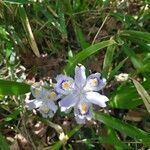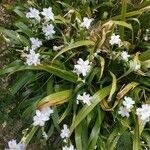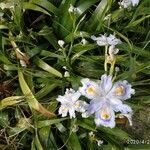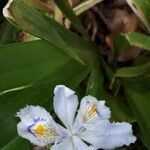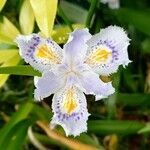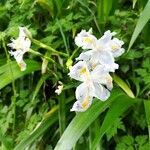Rhizomes dimorphic: suberect, thick; creeping, long, slender. Leaves basal, dark or yellowish green, glossy on 1 surface, dull on other, reddish purple at base, sword-shaped, 25--60 × 1.5--3 cm, midvein absent. Flowering stems erect, with 5--12 short, slender branches near apex; spathes 3--5, broadly lanceolate, 0.8--1.5 cm, 2--4-flowered, apex obtuse. Flowers pale bluish, 4.5--5.5 cm in diam.; pedicel 1.5--2.5 cm, stiff, persistent. Perianth tube 1.1--1.5 cm; outer segments obovate or elliptic, 2.5--3 × 1.4--2 cm, limb spreading, with blue blotching around central, yellow patch around prominent, yellow crest, margin denticulate, undulate, apex retuse; inner segments spreading obliquely, elliptic or narrowly obovate, 2.8--3 × 1.5--2.1 cm, margin denticulate, undulate. Stamens 0.8--1.2 cm; anthers white. Ovary 7--10 mm. Style branches pale blue; terminal lobes fimbriate. Capsule ellipsoid-cylindric, 2.5--3 × 1.2--1.5 cm, apex not beaked. Seeds dark brown, with small aril. Fl. Mar--Apr, fr. May--Jun. 2 n = 24*, 28, 34, 36, 54, 56*.
More
A fleshy stemmed iris. It grows 60-80 cm high and spreads 45-60 cm wide. The leaves are at the base and are shiny on one end and dull on the other. The leaves are sword shaped and 25-60 cm long by 2-3 cm wide. Both blue and white flowered types occur. Flowers have orange and purple markings.
Can be grown by divisions or seedlings. Seeds needs stratification.
